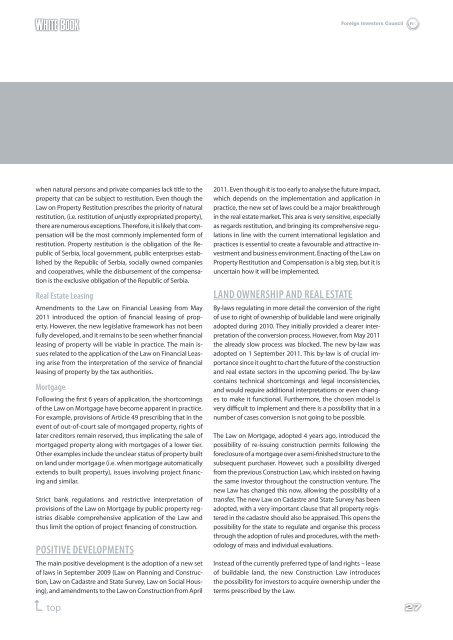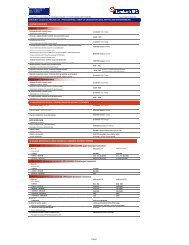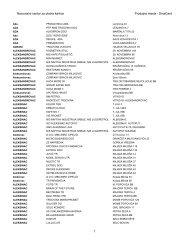Fic rEcommEndationS - Eurobank EFG
Fic rEcommEndationS - Eurobank EFG
Fic rEcommEndationS - Eurobank EFG
Create successful ePaper yourself
Turn your PDF publications into a flip-book with our unique Google optimized e-Paper software.
when natural persons and private companies lack title to the<br />
property that can be subject to restitution. Even though the<br />
Law on Property Restitution prescribes the priority of natural<br />
restitution, (i.e. restitution of unjustly expropriated property),<br />
there are numerous exceptions. Therefore, it is likely that compensation<br />
will be the most commonly implemented form of<br />
restitution. Property restitution is the obligation of the Republic<br />
of Serbia, local government, public enterprises established<br />
by the Republic of Serbia, socially owned companies<br />
and cooperatives, while the disbursement of the compensation<br />
is the exclusive obligation of the Republic of Serbia.<br />
real Estate Leasing<br />
Amendments to the Law on Financial Leasing from May<br />
2011 introduced the option of financial leasing of property.<br />
However, the new legislative framework has not been<br />
fully developed, and it remains to be seen whether financial<br />
leasing of property will be viable in practice. The main issues<br />
related to the application of the Law on Financial Leasing<br />
arise from the interpretation of the service of financial<br />
leasing of property by the tax authorities.<br />
mortgage<br />
Following the first 6 years of application, the shortcomings<br />
of the Law on Mortgage have become apparent in practice.<br />
For example, provisions of Article 49 prescribing that in the<br />
event of out-of-court sale of mortgaged property, rights of<br />
later creditors remain reserved, thus implicating the sale of<br />
mortgaged property along with mortgages of a lower tier.<br />
Other examples include the unclear status of property built<br />
on land under mortgage (i.e. when mortgage automatically<br />
extends to built property), issues involving project financing<br />
and similar.<br />
Strict bank regulations and restrictive interpretation of<br />
provisions of the Law on Mortgage by public property registries<br />
disable comprehensive application of the Law and<br />
thus limit the option of project financing of construction.<br />
PoSitiVE dEVELoPmEntS<br />
The main positive development is the adoption of a new set<br />
of laws in September 2009 (Law on Planning and Construction,<br />
Law on Cadastre and State Survey, Law on Social Housing),<br />
and amendments to the Law on Construction from April<br />
� top<br />
2011. Even though it is too early to analyse the future impact,<br />
which depends on the implementation and application in<br />
practice, the new set of laws could be a major breakthrough<br />
in the real estate market. This area is very sensitive, especially<br />
as regards restitution, and bringing its comprehensive regulations<br />
in line with the current international legislation and<br />
practices is essential to create a favourable and attractive investment<br />
and business environment. Enacting of the Law on<br />
Property Restitution and Compensation is a big step, but it is<br />
uncertain how it will be implemented.<br />
Land oWnErSHiP and rEaL EStatE<br />
By-laws regulating in more detail the conversion of the right<br />
of use to right of ownership of buildable land were originally<br />
adopted during 2010. They initially provided a clearer interpretation<br />
of the conversion process. However, from May 2011<br />
the already slow process was blocked. The new by-law was<br />
adopted on 1 September 2011. This by-law is of crucial importance<br />
since it ought to chart the future of the construction<br />
and real estate sectors in the upcoming period. The by-law<br />
contains technical shortcomings and legal inconsistencies,<br />
and would require additional interpretations or even changes<br />
to make it functional. Furthermore, the chosen model is<br />
very difficult to implement and there is a possibility that in a<br />
number of cases conversion is not going to be possible.<br />
The Law on Mortgage, adopted 4 years ago, introduced the<br />
possibility of re-issuing construction permits following the<br />
foreclosure of a mortgage over a semi-finished structure to the<br />
subsequent purchaser. However, such a possibility diverged<br />
from the previous Construction Law, which insisted on having<br />
the same investor throughout the construction venture. The<br />
new Law has changed this now, allowing the possibility of a<br />
transfer. The new Law on Cadastre and State Survey has been<br />
adopted, with a very important clause that all property registered<br />
in the cadastre should also be appraised. This opens the<br />
possibility for the state to regulate and organise this process<br />
through the adoption of rules and procedures, with the methodology<br />
of mass and individual evaluations.<br />
Instead of the currently preferred type of land rights – lease<br />
of buildable land, the new Construction Law introduces<br />
the possibility for investors to acquire ownership under the<br />
terms prescribed by the Law.<br />
27




